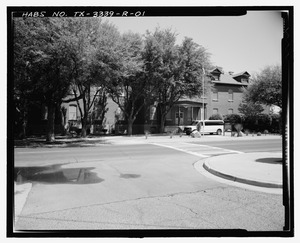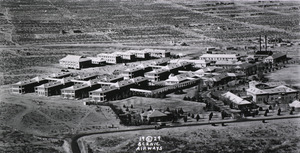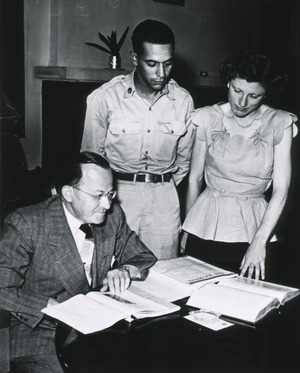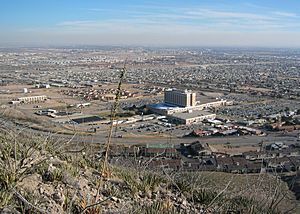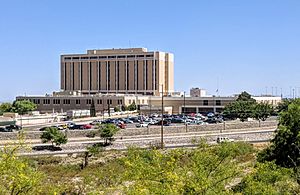William Beaumont Army Medical Center facts for kids
Quick facts for kids William Beaumont Army Medical Center |
|
|---|---|
| Defense Health Agency | |
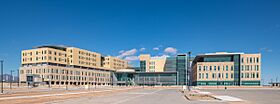 |
|
| Geography | |
| Location | El Paso, Texas, United States |
| Coordinates | 31°49′58″N 106°19′31″W / 31.8327°N 106.3253°W |
| Organization | |
| Care system | Tricare |
| Hospital type | Teaching hospital, General |
| Affiliated university | Paul L. Foster School of Medicine |
| Services | |
| Emergency department | Level II Trauma Center |
| Helipad | 31°50′09″N 106°19′39″W / 31.8357°N 106.3275°W |
| History | |
| Founded | 1849 |
The William Beaumont Army Medical Center (WBAMC) is a special hospital for the United States military. It's located in Fort Bliss, Texas. This hospital helps active military members, their families, and retired service members. It also has an emergency department for people in Northeast El Paso.
A new, big hospital complex with six buildings opened on July 10, 2021. WBAMC also works with the Paul L. Foster School of Medicine and trains future doctors and nurses from other universities.
Contents
- A Look Back: History of WBAMC
- Fisher House: A Home Away From Home
- WBAMC's Special Symbol
- Working Together: VA Health Care
- See also
A Look Back: History of WBAMC

The William Beaumont Army Medical Center is named after a famous Army surgeon, William Beaumont (1785–1853). He is known as the "Father of Gastric Physiology" because he studied how the human stomach works. The hospital was officially named after him in 1921.
Early Days of Fort Bliss (1849–1892)
The medical care for soldiers in El Paso started way back in 1849. The Army's base, which became Fort Bliss, moved several times. In 1854, it was officially named Fort Bliss.
The hospital was simple in the 1860s, but it helped soldiers who were sick. The fort and its hospital moved around El Paso several times. Finally, in 1893, Fort Bliss moved to its permanent spot at La Noria Mesa. This is where the hospital and fort are still located today.
In 2012, archaeologists found parts of an old Army hospital from the 1880s. This hospital was built by soldiers themselves.
Civil War Times (1861–1862)
During the American Civil War, Texas left the Union. Fort Bliss and its hospital were taken over by Confederate forces in 1861. They remained under Confederate control until 1862. When the Confederate troops left, they destroyed most of Fort Bliss, but they saved the hospital because it was caring for their sick and wounded.
Building a Permanent Hospital (1893–1898)
In the 1890s, a permanent hospital was built at Fort Bliss. This hospital, completed in 1893, is now known as Building 8. It is part of the Fort Bliss Main Post Historic District and was added to the National Register of Historic Places in 1972.
Supporting Soldiers (1898–1902)
During the Spanish–American War, the hospital at Fort Bliss supported a small group of soldiers. After 1902, when the Philippine–American War ended, the hospital began to support more troops. By this time, many of the buildings at Fort Bliss, including the hospital, needed repairs.
A New Hospital Building (1903–1919)
In 1903, it was clear that Fort Bliss needed a new hospital. A new building was started in 1904.
During World War I, a field hospital company from Fort Bliss went to France in 1917 to help soldiers on the Western Front.
The first Army dental training school was also started at the Fort Bliss Post Hospital in 1916. This school helped train many dental professionals for the Army.
William Beaumont General Hospital (1920–1939)
The new hospital at Fort Bliss was named William Beaumont General Hospital. It opened on July 1, 1921, and was finished in 1922. It had 41 buildings and 403 beds, with space for 100 more if needed. The buildings were made of tile and stucco.
This new hospital made Fort Bliss an important military medical center. It provided care for soldiers at Fort Bliss and in other parts of the western United States. By the 1930s, it was helping soldiers in Arizona, New Mexico, and western Texas.
World War II and Beyond (1940–1968)

During World War II, William Beaumont General Hospital was one of many hospitals that cared for prisoners of war in the United States.
In 1945, the hospital treated about 6,000 patients. It also had a school that trained medical technicians in many areas, like surgery, dental care, and X-rays. The hospital also had centers for physical and occupational therapy. It became a special center for plastic surgery and eye surgery. During the war, about 16,000 medical technicians were trained here.
After World War II, William Beaumont General Hospital was one of only ten Army hospitals that stayed open. It continued to provide medical care for soldiers returning from the Korean War and the Vietnam War. It also helped veterans and military personnel at Fort Bliss.
William Beaumont Army Medical Center Today (1969–Present)
In 1969, the Army started building a new, tall hospital. This new building, finished in 1972, became the William Beaumont Army Medical Center. It is a modern building with a 12-story tower.
The hospital can care for over 150 patients. If there's an emergency, it can expand to hold up to 373 patients. As the main Army medical center in the Southwest, it provides care for active and retired military members and their families in Texas, New Mexico, and Arizona.
Major General (Dr.) Charles C. Pixley, who was the hospital commander from 1975 to 1976, later became the top doctor for the entire Army.
Fisher House: A Home Away From Home
The Fisher House Foundation helps military families by providing free places to stay when a family member is in the hospital. There is a Fisher House facility at WBAMC. It celebrated its 20th anniversary in 2014, showing how long it has helped families.
WBAMC's Special Symbol
The special symbol, or unit insignia, for WBAMC tells a story. It includes parts that represent Dr. William Beaumont, his patient Alexis St. Martin, the hospital's medical history, and its location in El Paso.
- The fleur-de-lis points north, showing where Dr. Beaumont worked in Michigan in 1820.
- The circular window in the middle of the cross represents Alexis St. Martin's stomach wound, which never fully closed. This allowed Beaumont to study how the human stomach works.
- The white and maroon colors are the traditional colors of the US Army Medical Department.
- The Maltese cross is a symbol of the medical profession, like the Knights Hospitallers from medieval times.
- The mountains and blue wave show WBAMC's location in El Paso. "El Paso" means "the pass" in English, referring to a mountain pass, and the blue wave stands for the Rio Grande river.
Working Together: VA Health Care
The El Paso VA Health Care System works closely with William Beaumont Army Medical Center. They share resources to help more patients. For example, the VA buys emergency and inpatient care from WBAMC. This teamwork has helped more veterans get important surgeries.
See also
- MEDCOM
- Uniformed Services University of the Health Sciences
- Paul L. Foster School of Medicine
- Dr. William Beaumont
- Major General (Dr.) Charles C. Pixley
- Fort Bliss
- General Omar Bradley
- Sergeant Major of the Army William O. Wooldridge




